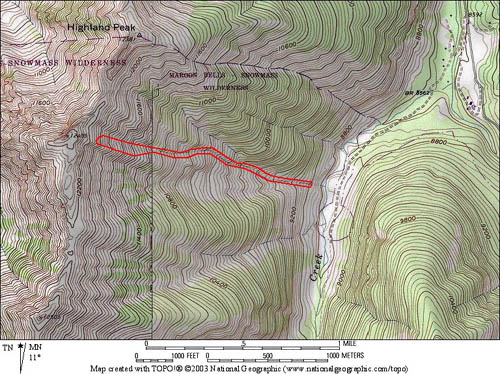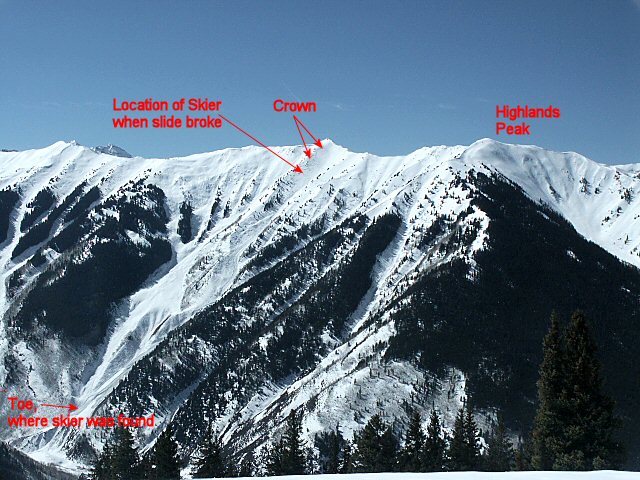
At about 1445 hours Sunday afternoon a 32 year-old man was buried and killed in a sizable avalanche in the backcountry near the Aspen Highlands Ski Area. At the of the avalanche the man was participating in a Level II avalanche-awareness class in Five Fingers Bowl. (Five Fingers Bowl has become a popular out-of-area ski tour adjacent to the Aspen Highlands ski area. Access is either from the top of Highlands Peak via a USFS backcountry access gate or to climb from the bottom starting at Conundrum Creek.) He was the only person caught.

Details are few and what follows is preliminary and subject to change. We know the group had dug several snow pits across the top of the bowl as they traversed southward. Stability tests indicated moderate shears or what we might call "so-so conditions;" the tests and pits apparently did not reveal obvious instability or stability. The group -- skiing one at a time -- were working their way down a prominent rib and gully below the "thumb" (point 12,495). A skier would ski toward the gully or perhaps even in the gully and then traverse back to the rib to wait for the next skier. The victim -- skiing third -- skied into or toward the gully and fell and rolled. This triggered the avalanche that broke some distance above him and swept him down nearly the entire track.


Five Finger Bowl avalanche as seen from Aspen Mountain. The avalanche occurred directly below the "thumb" or point 12,495. Evidence of old avalanches can be seen on similar slopes; however, we have been told the slope that avalanched on Sunday afternoon had also avalanched earlier in the winter. Photo ęDoug Driskell, 2005.
Words likely cannot describe the horror the group experienced watching one their own swallowed up in a churning torrent of snow. They descended quickly but cautiously; at one point they had to remove their skis to down climb a rock band. It may have taken as long as 20-30 minutes to reach the debris and a transceiver signal was quickly detected. It was only a matter of minutes before they had pinpointed the signal and started digging. They found their friend under 3-4 feet of snow, and started CPR for at least an hour without success.
Minutes after the avalanche 2 members of Mountain Rescue Aspen were driving from Ashcroft back to Aspen when they noticed the fresh looking avalanche. From the road and using binoculars they were able to see ski tracks including one track ending at the fracture line. They could not see the skiers and drove a short distance down the road and looked again. This time they could see the skiers descending the debris. It was a short time later their rescue pagers sounded with the report of the accident. They quickly drove to the "trailhead" and started up to help. The body was evacuated by the group and by Mountain Rescue Aspen. The Aspen Times web site wrote the Pitkin County Coroner's Office said the victim died from asphyxiation.

Looking up from the bottom of the avalanche. The debris at this location was wet. The victim was found about 200 yards upslope from the end of the debris. Photo ęScott Messina 2005.
Early reports classify the avalanche as a SS-AS-3-O. This medium to large-sized avalanche -- large, only because it ran so far -- released about 3 feet deep by about 150 feet across. The slab fractured 200 feet above the helpless skier. The fracture line was just below 12,200 feet and the avalanche fell about 3,000 vertical feet, stopping below 9,200 feet, or just short of the last steep pitch above Conundrum Creek. The avalanche released from the steep northeast-facing side of the gully in cold, dry snow, but by the time the avalanche stopped it had plowed into wet snow low in the runout. The victim was found about 200 yards uphill of the toe or end of the debris.
The weather on Sunday the 6th was beautiful and spring-like; however, it was not a cause for the accident. Though snow near the valley floor was wet, the snow high in Five Finger Bowl was cold, and dry. Temperatures at the time of the accident were in the upper 20s and a light breeze blew from the west.
Temperatures during February and for the first six days of March were very mild. The average daily temperatures stayed in the upper teens to upper 20s for nearly the entire month. Only on three days did the average daily temperature barely dipped below 10F, and those days were weeks earlier.
As mild as temperatures were, February snowfall at both Aspen Highlands and Aspen Mountain was probably about normal with 40 and 46 inches reported. At higher elevations like the upper reaches of Highlands Bowl and Five Fingers Bowl, even more snow fell. In the first few days of March, 2.4 and 4.6 inches of new snow were reported at Aspen Highlands and Aspen Mountain.
Winds were almost as mild as the temperatures for the month of February and early March; however, on a few days around the Presidents Weekend some brisk southwest winds did cause some blowing and drifting snow at mountaintop levels.
Few exact details are known. Most likely a persistent layer of faceted, sugar-like grains that formed during the dry and mild last 2 weeks of January were the culprit. This particular slope may have avalanched earlier this season, leaving behind a generally shallow snow cover where a strong temperature gradient weakened the snowcover. If the slope did not avalanche, near-surface facets formed during the dry end of January. In both situations the weak snow was buried by February snows. As we learn more information about the snow cover, we will pass it along.
The backcountry avalanche danger posted (telephone hotlines) Sunday morning for the C mtns was "overall MODERATE near and above treeline. Below treeline LOW. Crested Butte zone: MODERATE overall."
All avalanche accidents ending with serious injuries or death are tragic, especially for the friends and family of the victim. This accident strikes close to home for many of us who work in avalanche terrain and especially for those of us who teach avalanche education.
Atkins, updated on March 7 at 2300 hours.